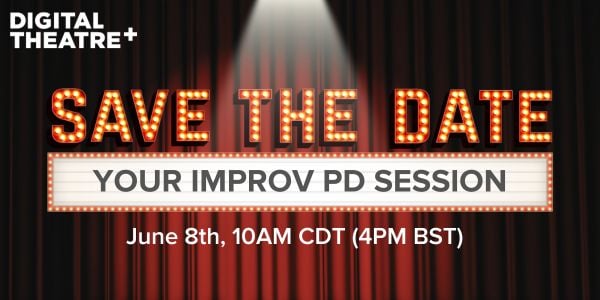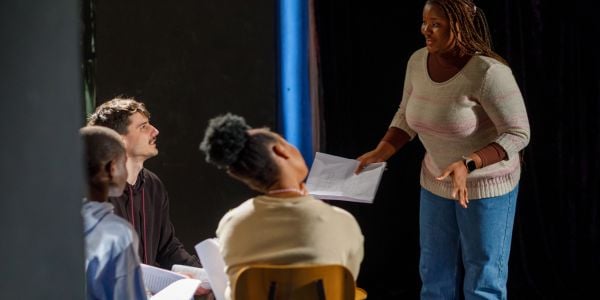We know that teaching improvisation can be a struggle for many teachers! From the spontaneity of being in the moment, to inventing new material on the spot, it's not only teachers who can struggle, but students too. Improvisation is an essential skill for any performer, whether they're an actor, musician, or dancer. It allows them to think on their feet, react in the moment, and create something new and unique. But fear not, here are some best practices for teaching improvisation to middle and high school students who may be self-conscious or hesitant:
1. Create a Safe and Supportive Environment
The first step in teaching improvisation is to create a safe and supportive environment for your students. One way would be to create a Class Social Contract. A social contract is an agreement between you and your class on a set of expectations you create together and all sign – and since everyone has created and agreed on the expectations, everyone is responsible for holding each other accountable for adhering to them. Take a look at this blog written by a former teacher on how she created her social contract. Encourage them to take risks and make mistakes without fear of judgment or ridicule. Students need to trust each other and know that their ideas are being supported, watch our useful video on using the Yes, And technique to learn more.
2. Start with Simple Ice Breaker Exercises
Begin with simple exercises that focus on listening, responding, and staying in the moment. For example, you could begin with ‘Brand your name'. This easy exercise involves starting in a small group and taking it in turn to say your name and then a word that says something about you, accompanied by a relevant action. Go around the circle to join your name and the action together, at the same time. Then again, join your name and the action together but now follow this with someone else’s name and action. That person then repeats their name and action and chooses someone else. Keep passing this around the circle. This accessible exercise can ease students into being comfortable with their peers and scene partners. See it in action over on DT+.
3. Build on Basic Improv Techniques
There are a number of basic improv exercises that you can introduce to your students to help with their initial understanding. For example, to learn how to use emotions you could use ‘The Rant’ exercise. Gather students into small groups, and provide them with a topic, such as ‘the weather’. Then point at students, when pointed at they should start talking about something relating to a topic that annoys them, after each round the intensity of their annoyance should increase until they are at a rage stage. By building up to rage, students begin to explore varying levels of emotion.
Once your students are comfortable with basic exercises, you can begin to build on those techniques. For example, you could introduce different genres or styles of improvisation, such as short-form, where shows are made up of short scenes perhaps using audience suggestions, or long-form improv which is a continuous piece inspired from a suggestion at the start. You could also begin to incorporate props or costumes to inspire creativity.
4. Encourage Student Collaboration
Improvisation is a collaborative art form, so it's important to encourage your students to work together. Emphasize the importance of supporting each other's ideas and building on them, rather than trying to ‘win’ or be the star of the show. The ‘Yes, and’ exercise is a well-established improvisation exercise. To begin students should be in pairs or small groups. Provide the students with a suggestion to begin the scene, this could be ‘a birthday party’ or ‘the cinema’. Students must begin the scene with a statement, the next person must start their lines with ‘yes, and’ and continue with their lines. Repeat the scene, but this time do not directly say ‘yes and’. Instead keep this as subtext. Watch this activity in action in the video 'Yes, And' over on Digital Theatre+.
5. Reflect and Debrief
Finally, make time for reflection and debriefing after each improvisation exercise or performance. Ask your students what worked well, what could be improved, and what they learned. Encourage them to give and receive constructive feedback, and to celebrate their successes.
Looking for more ways to support your students with improvisation? Sign up to our upcoming webinar ‘Inspired by Improv: Practical Tips for the Ultimate Improvisation Lessons’

Need some summer PD? Or want to learn more about teaching improv? Look no further! Inspired by Improv is a professional development experience that features a live webinar from an expert panel of improv actors, theatremakers, and teachers to give you innovative tips, ideas and guidance on teaching the best improv lessons! You will also have the opportunity to ask your burning questions, which you will be invited to submit before the event.
When: June 8th, 10:00am CDT (4:00pm BST)
Register here for a spot on this exciting webinar!
Exercises featured in this blog have been taken from our new How to: Improvisation Series, offering a range of short accessible e-learning videos demonstrating how to develop key skills related to improvisation. Each episode is led by a theatre professional and includes clear step-by-step instructions. There is also an accompanying workbook for this series.
If you’d like access to any of these resources and are not yet a customer of Digital Theatre+, please get in touch with a member of our team today. If you already have a subscription, click here.
Related blogs
The Stanislavski Method: Practical Exercises for High Schoolers
Born in 1863, Konstantin Stanislavski was a Russian actor, director, and theorist.
Read more8 educators to follow on social media (and 10 hashtags to check out)
It may be that you’re already a social media pro, fully equipped with accounts specifically...
Read moreTheatre & Performance: top 5 blog posts of 2022
Featuring leading scholars and theatre-makers including Anne Bogart and Katie Mitchell, discover a...
Read moreGet the latest teaching tips straight to your inbox
Explore free lesson ideas and inspiration, education news, teaching trends and much more by signing up to regular blog updates!





